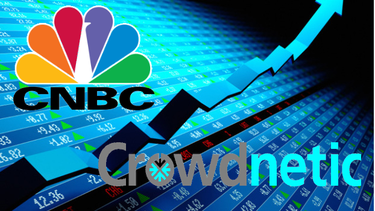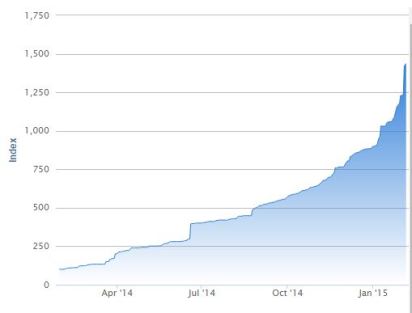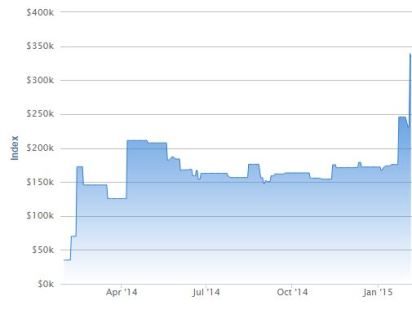 Crowdnetic and CNBC have come together to create the first true Crowdfunding Index (or in this case indices) designed to track the growth of the Crowdfunding market. For whatever reason, nothing seems to quite make an investor stand up and take notice like good chart (particularly ones showing exponential growth). That’s why I see these indices as a huge step forward in brining Crowdfunding into the financial mainstream.
Crowdnetic and CNBC have come together to create the first true Crowdfunding Index (or in this case indices) designed to track the growth of the Crowdfunding market. For whatever reason, nothing seems to quite make an investor stand up and take notice like good chart (particularly ones showing exponential growth). That’s why I see these indices as a huge step forward in brining Crowdfunding into the financial mainstream.
For those of us deep in the industry, it is often hard to remember that the majority of the general population knows very little about Crowdfunding, doesn’t trust it, or both. This is primarily the result of a general lack of knowledge about Crowdfunding and its potential, or the plethora of misinformation surrounding Crowdfunding investments. I believe that these indices will go a long way in helping to bring Crowdfunding into the mainstream and toward further legitimizing Crowdfunding a viable investment and financing vehicle.
Since late 2013 Crowdnetic, a leading provider of Crowdfunding data, has been tracking all of the fundraising from 16 of the leading Crowdfunding portals including: AngelList, Crowdfunder, EarlyShares, EquityNet, Patch of Land, RealCrowd, RealPartner, Realty Mogul, SeedInvest and WeFunder. These portals publish anonymous data to Crowdnetic, in real-time, regarding completed and in-progress offerings. Even more impressive, at any one time, there are upwards of 3,500 active companies being tracked by, and feeding data to, Crowdnetic. As Luan Cox, founder and CEO of Crowdnetic was quoted as saying “[w]e see what’s being invested in, what kinds of companies those are, and the geographic locations they’re in.”
to, Crowdnetic. As Luan Cox, founder and CEO of Crowdnetic was quoted as saying “[w]e see what’s being invested in, what kinds of companies those are, and the geographic locations they’re in.”
Crowdnetic and CNBC have now aggregated Crowdnetic’s data and released the “Crowdfinance 50 Index,” which represents the daily average index of the 50 largest capital commitments raised by the Crowdfunding sites tracked by Crowdnetic. As stated the “Companies represented on the index are operating companies raising money, not equity funds. They represent eight sectors: commerce and industry; consumer goods; energy; finance; health care; materials; services and technology” (…. pssst CNBC, what happened to Real Estate??). The data is further refined into several specialty indices including the “Crowdfinance Real Estate Average Index,” the “Services Index,” the “Crowdfinance Technology Index,” and even a “Vice Average Index” (being the daily average of total capital commitments for “vice” companies including adult entertainment, tobacco, nightclubs/services, alcohol, gambling, and weapons).
As Cox noted, there is a lot of important information that can be garnered from the indices. For example, as the Crowdfinance 50 Index shows, the average Crowdfunding commitment rose over 1400% during 2014, did you know that??
Sadly however, investments in cigarettes, guns and pornography remained relatively flat:
All joking aside, I absolutely love these indices and I applaud Crowdnetic and CNBC in their efforts to make this information available to the public. I am particularly ecstatic about the strict use of the term “Crowdfinance” rather than Crowdfunding. I believe that differentiating investment based Crowdfunding from the Kickstarters of the world is absolutely necessary and little nuances like terminology will eventually make a big difference.
Sure I have a few nits about the indices, for example: (a) they do not have a category for real estate in the Crowdfinance 50 Index (as noted above) when they specify that Crowdnetic is tracking multiple real estate portals; and (b) the indices all claim to be tracking “equity” Crowdfunding but I know for a fact that a majority of the tracked portals  offer debt offerings as well (some primarily), so it is unclear whether these indices include such debt offerings. Also, and maybe it’s just my opinion, but I think that CNBC should drop the “vice” index. If the intent is to legitimize the industry does it really help for a curious investor to know that Crowdfunding helped Plausible Films, LLC raise $80,000 for “Film Production” (which, I can only assume, is of the adult nature given the category)? Probably not. That being said, all new products need tweaking and these indices are no different.
offer debt offerings as well (some primarily), so it is unclear whether these indices include such debt offerings. Also, and maybe it’s just my opinion, but I think that CNBC should drop the “vice” index. If the intent is to legitimize the industry does it really help for a curious investor to know that Crowdfunding helped Plausible Films, LLC raise $80,000 for “Film Production” (which, I can only assume, is of the adult nature given the category)? Probably not. That being said, all new products need tweaking and these indices are no different.
Notwithstanding the minor items above, I truly believe that these indices represent an important step forward in educating the general public about the vast potential of Crowdfunding. This is extremely important given the fact that, despite the exponential growth illustrated by the chart above, the Crowdfunding industry has merely scratched the surface of potential investors. As Cox noted “there are over 8 million accredited investors, yet less than 3 percent have invested in a private deal.” There is only one way to tap into the other 97% of potential investors and that is by bringing Crowdfunding (or should I say “Crowdfinance”) into the financial mainstream and getting people talking. With companies like CNBC now recognizing the potential of Crowdfunding and getting involved, its looks like we are on our way to actually making that happen.
the other 97% of potential investors and that is by bringing Crowdfunding (or should I say “Crowdfinance”) into the financial mainstream and getting people talking. With companies like CNBC now recognizing the potential of Crowdfunding and getting involved, its looks like we are on our way to actually making that happen.



Anthony, another superbly researched and written article. This is a major step forward for equity crowdfunding. As the truth about crowdfunding becomes more evident the industry is going to explode. The applications for equity crowdfunding is limitless. I am on a board with a man that develops franchises and after a board meeting one day we spoke of the perfect match of funding franchises and equity crowdfunding. He is now hooked:)